Abstract
To investigate some of the pathophysiological mechanisms in cerebral palsy, surface electromyograms (EMG) were recorded from pairs of flexor/extensor muscles during both voluntary and passive flexion/extension of upper and lower limbs of 20 patients. Elbow, knee, or ankle joint angles were measured simultaneously, as well as the force required to flex/extend the limbs passively at frequencies of 0.1--1.0 Hz. In addition, single motor units were recorded from the first dorsal interosseous muscles of six of the patients. Almost all patients showed resistance to passive movements (hypertonia). This hypertonia did not necessarily impair voluntary flexion/extension movements if alternating EMG activity was maintained in at least one of the pairs of flexor/extensor muscles involved in the movement. In six severly involved patients, there was a complete breakdown in the reciprocal relationship between reciprocally acting pairs of flexor/extensor motoneurones, which resulted in synchronous activation (co-contractions) of flexor/extensor muscles during both voluntary and passive movements. In these patients the hyperactive segmental reflex added to the disabling effects of co-contractions during voluntary movements. Single motor units recorded from patients with dystonic movements were recruited with variable delays (2--10 s) and usually discharged intermittently at high frequencies (60--120/s). This abnormla motor unit discharge pattern may relate to pathology of the basal ganglia.
Full text
PDF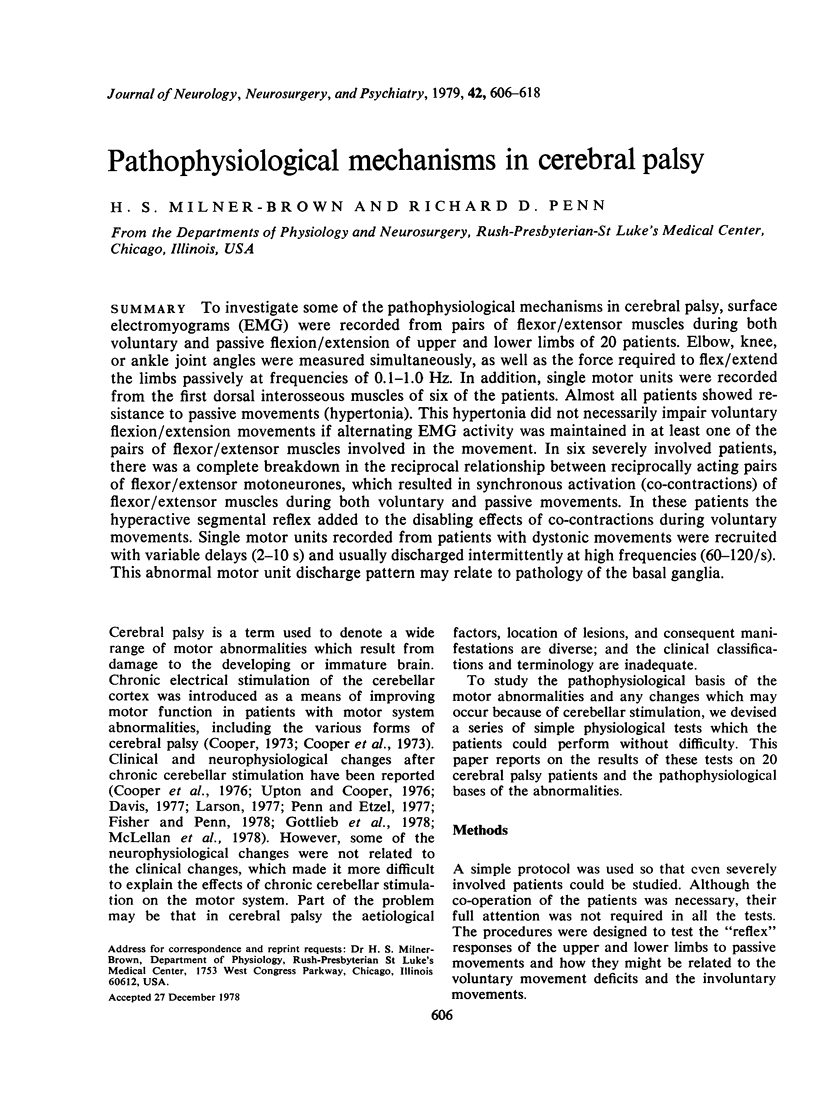
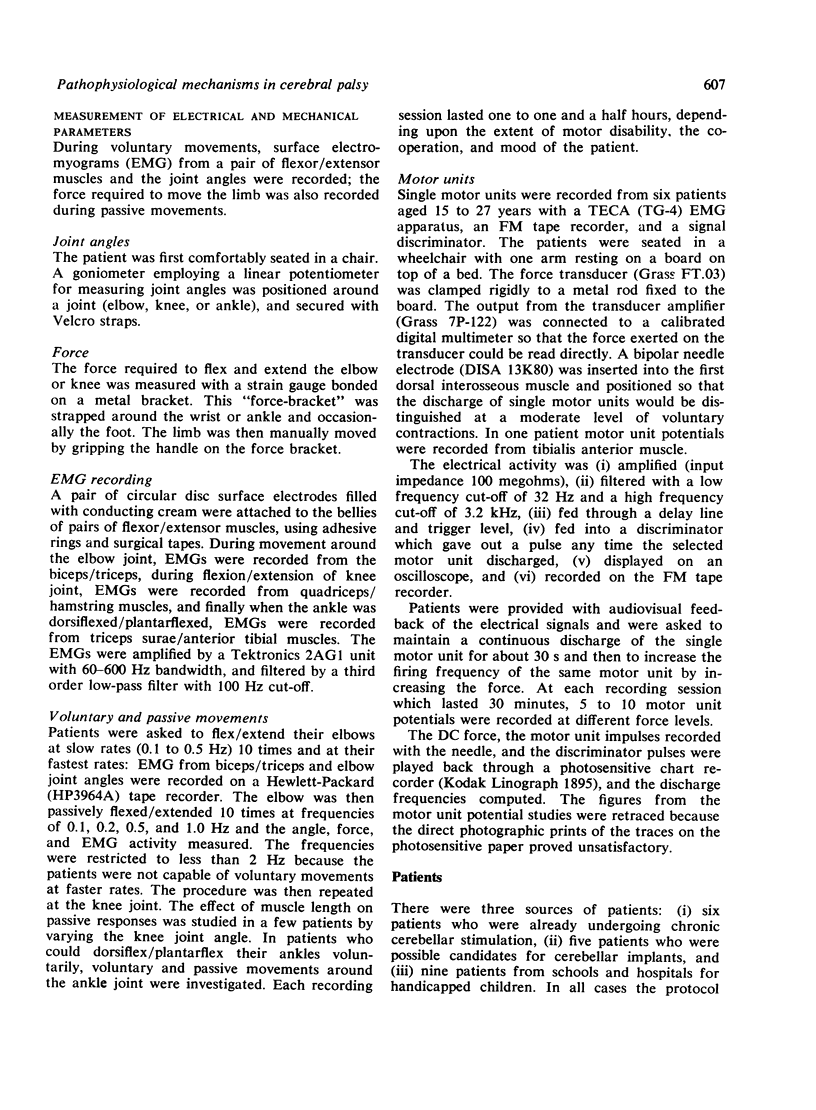
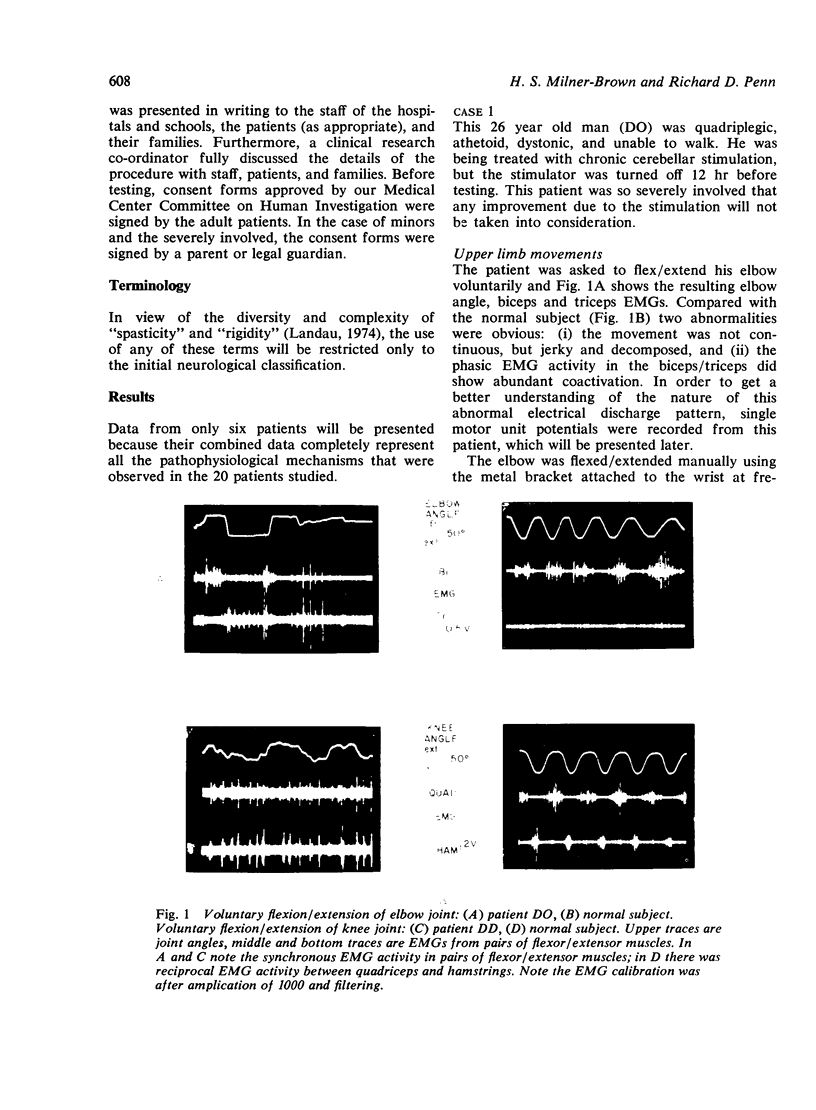
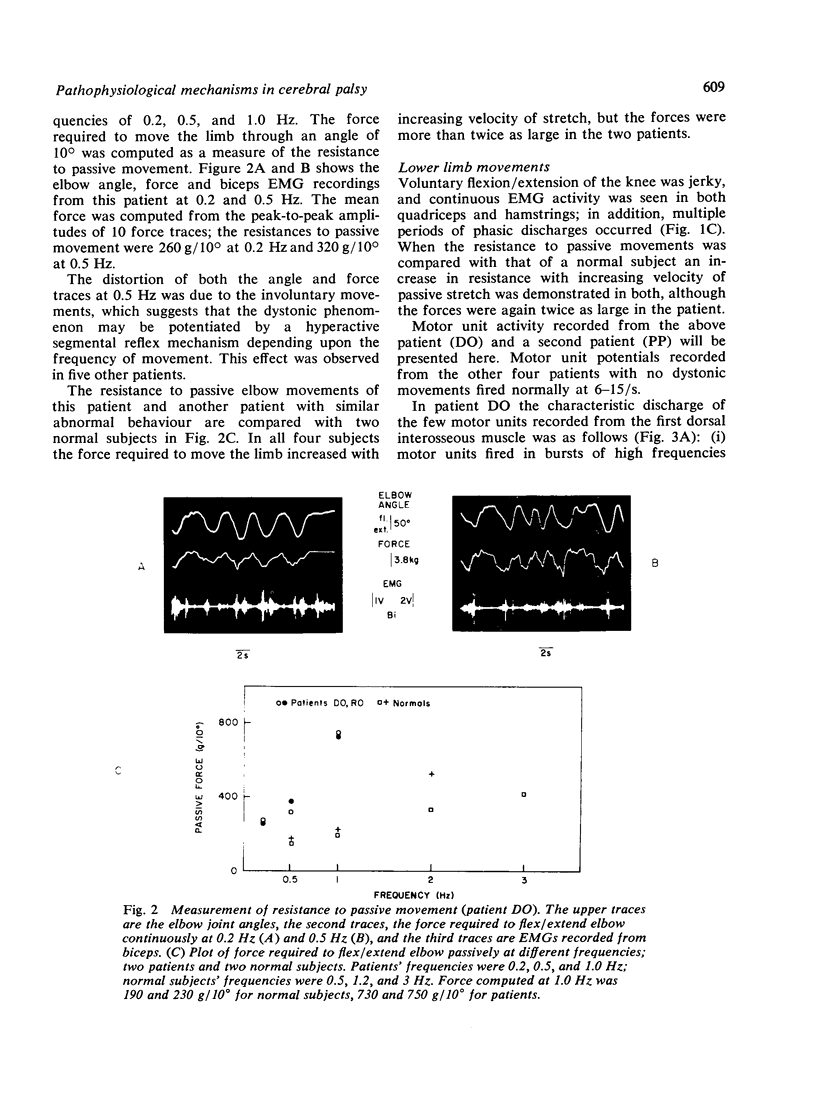
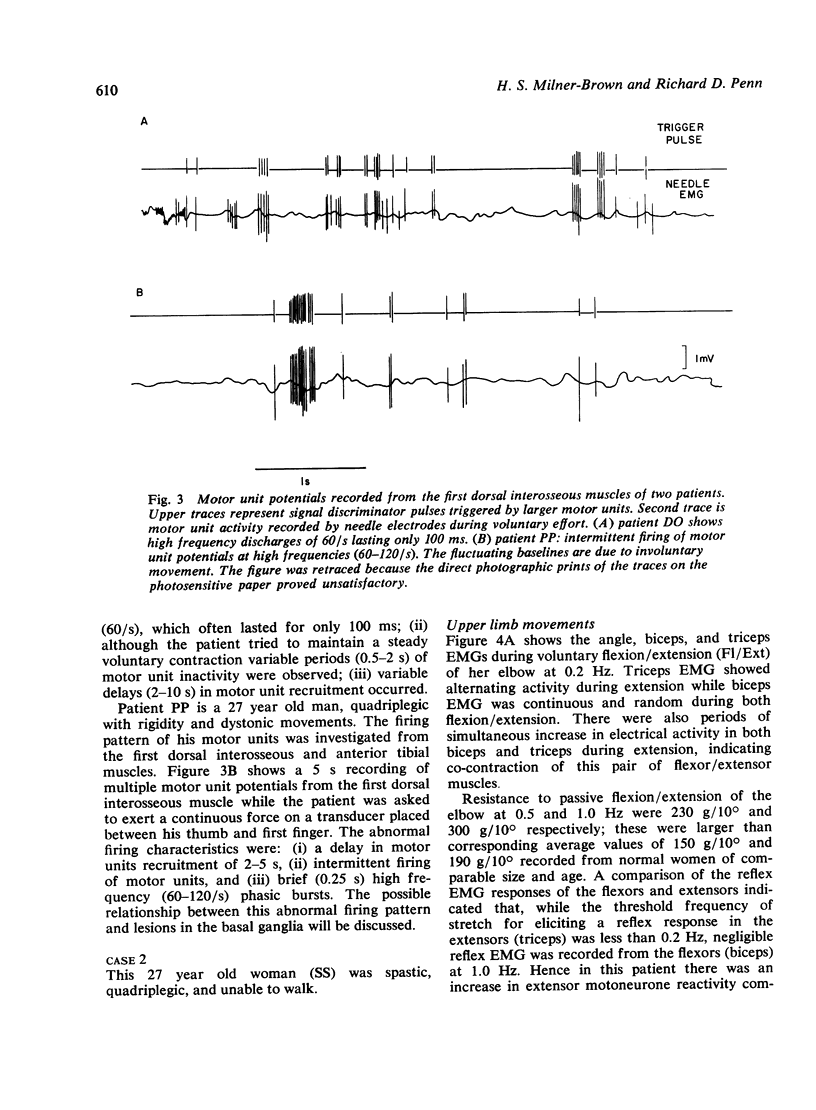
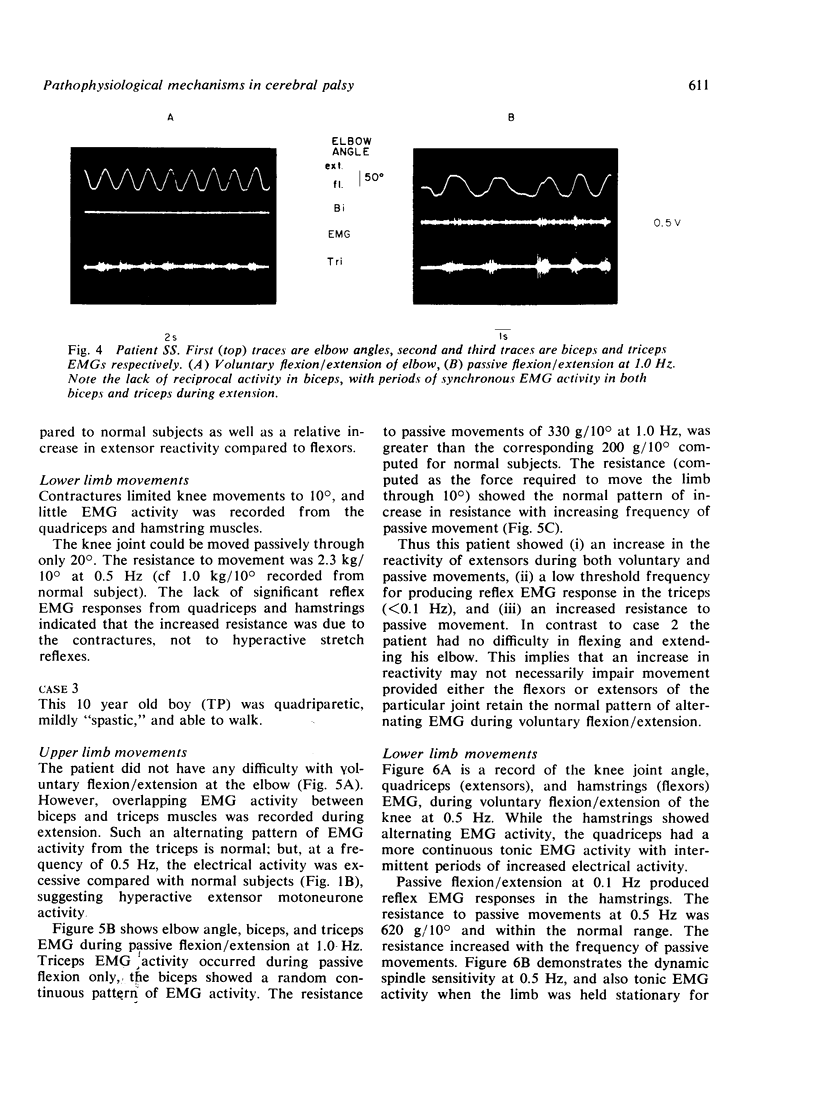

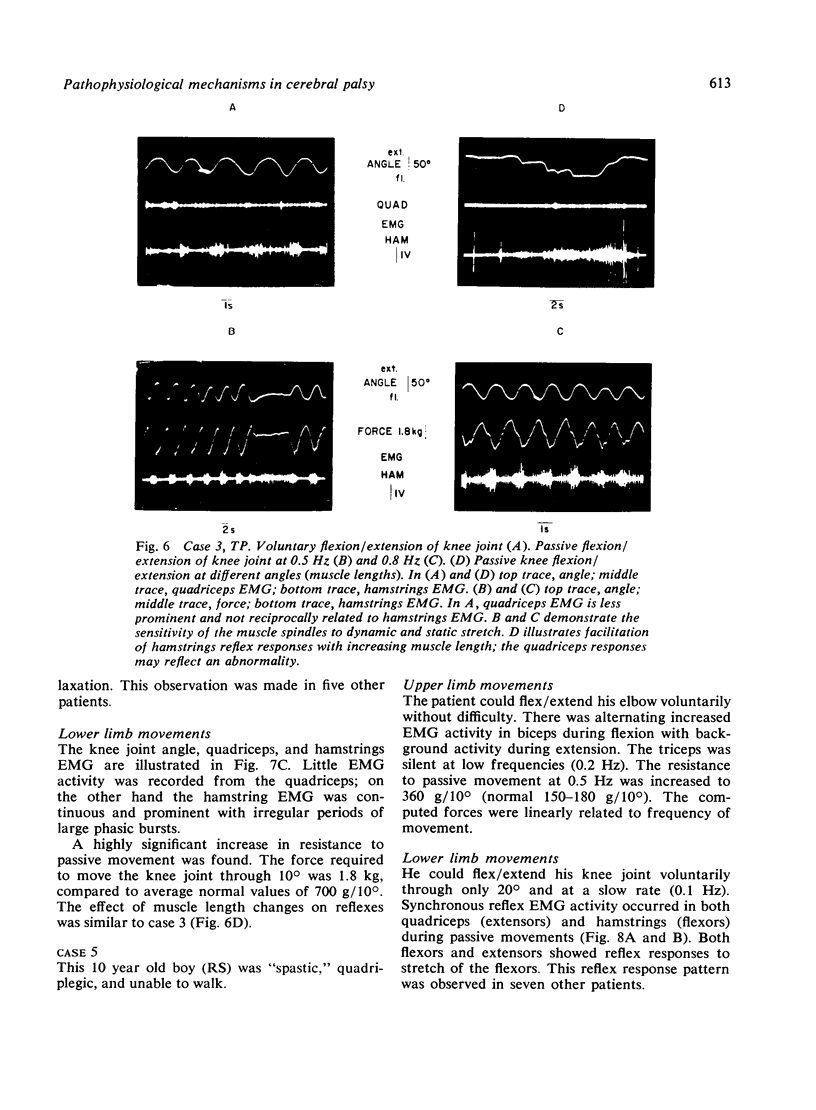
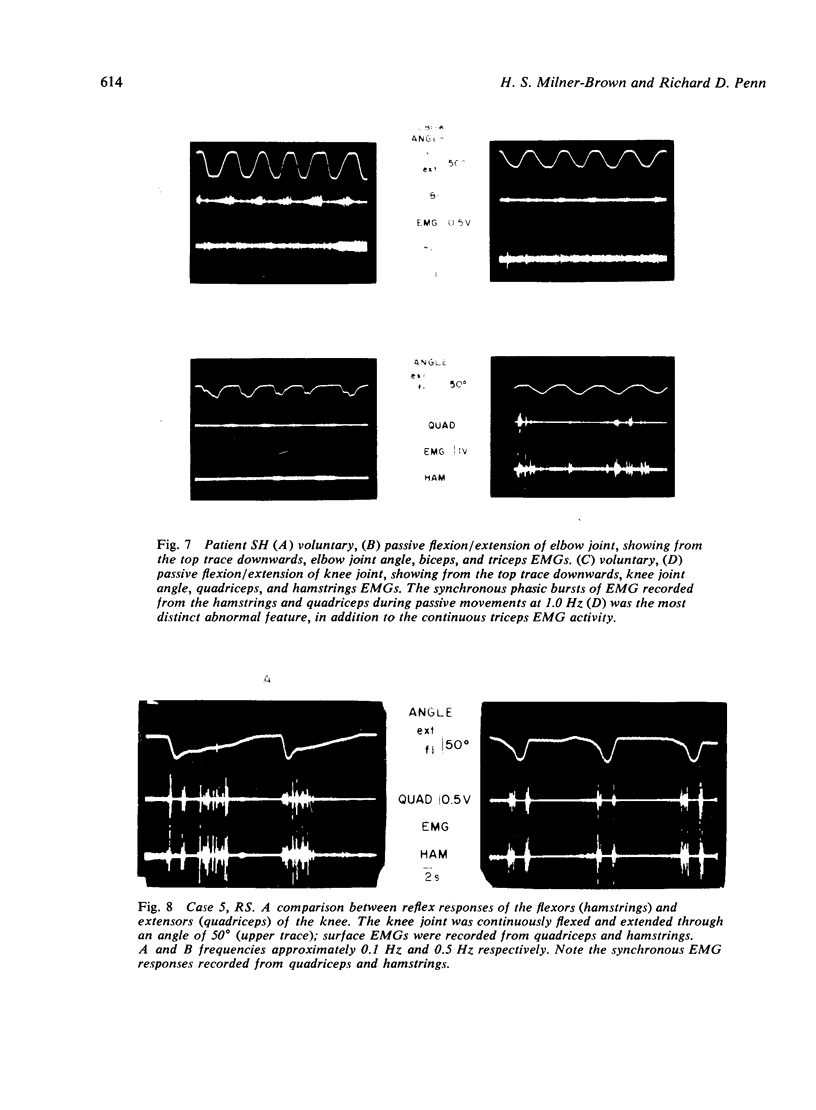
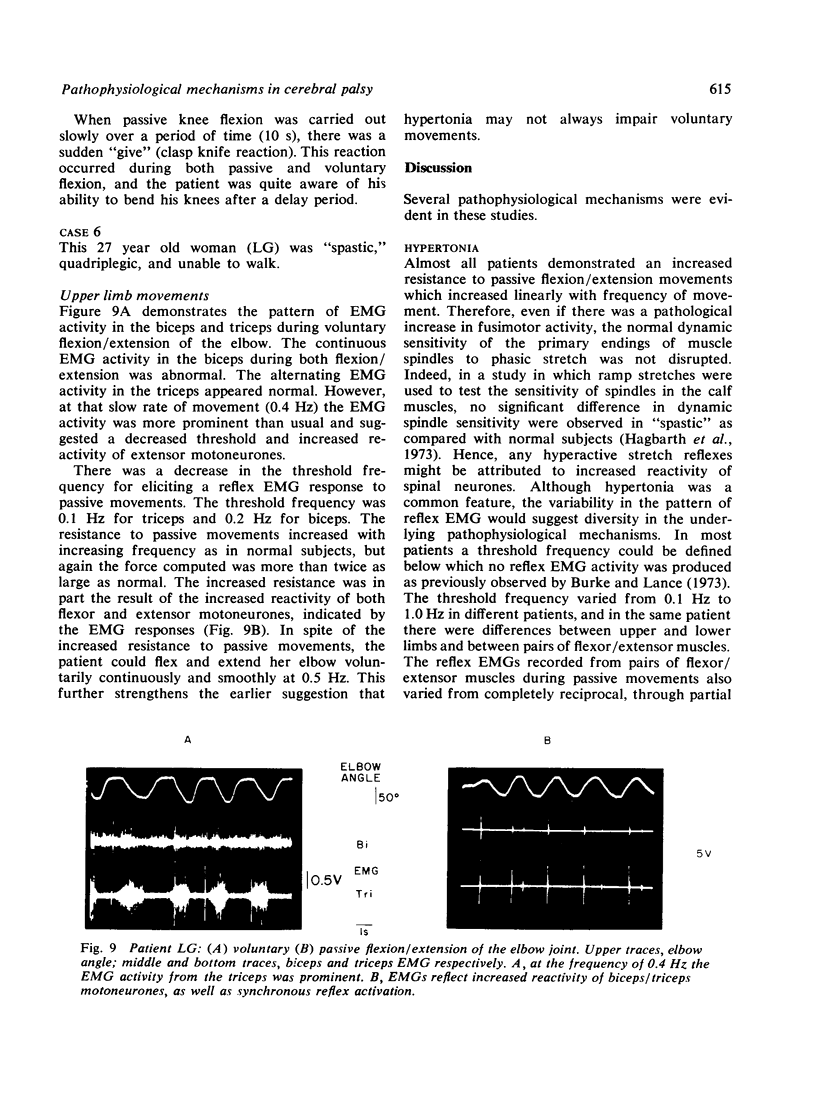
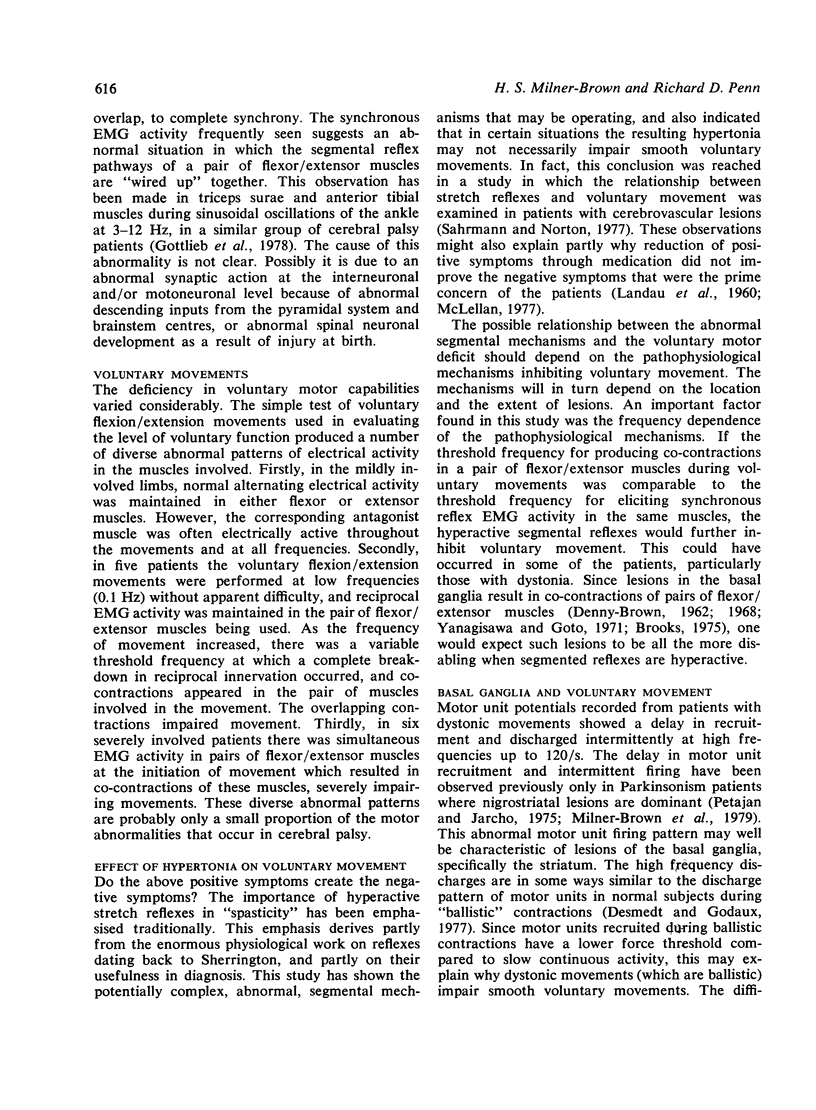
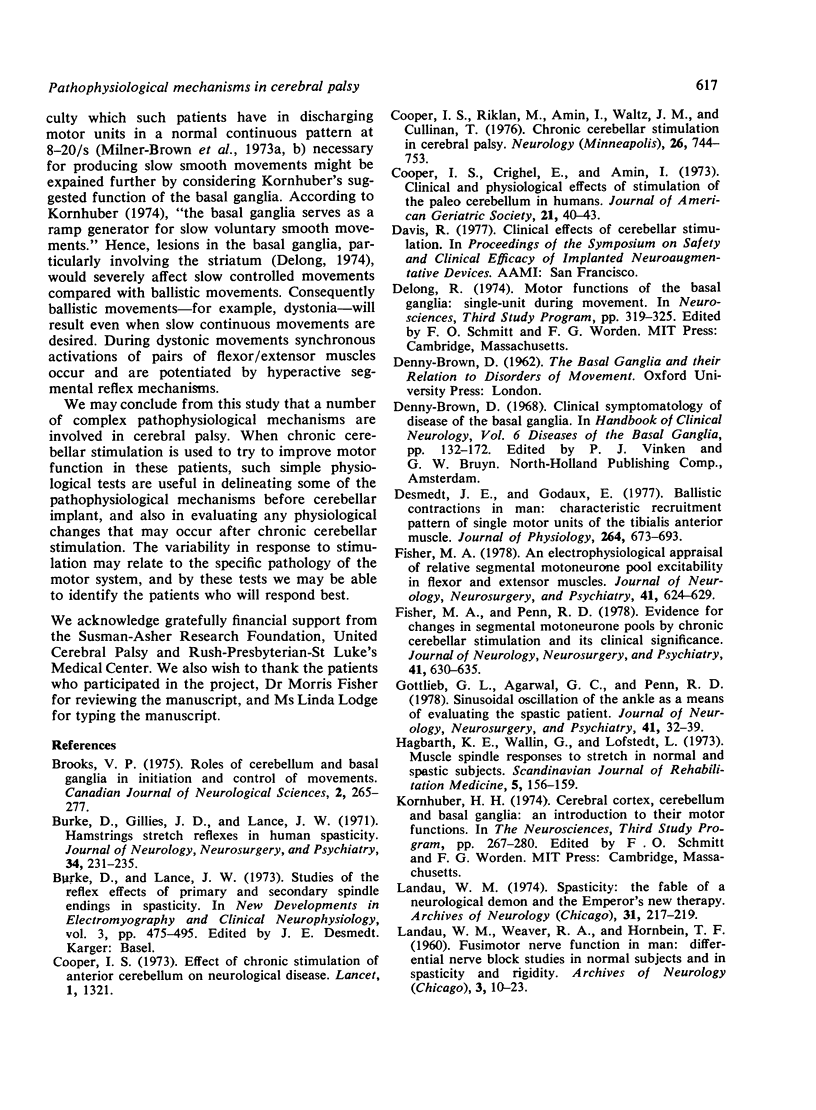
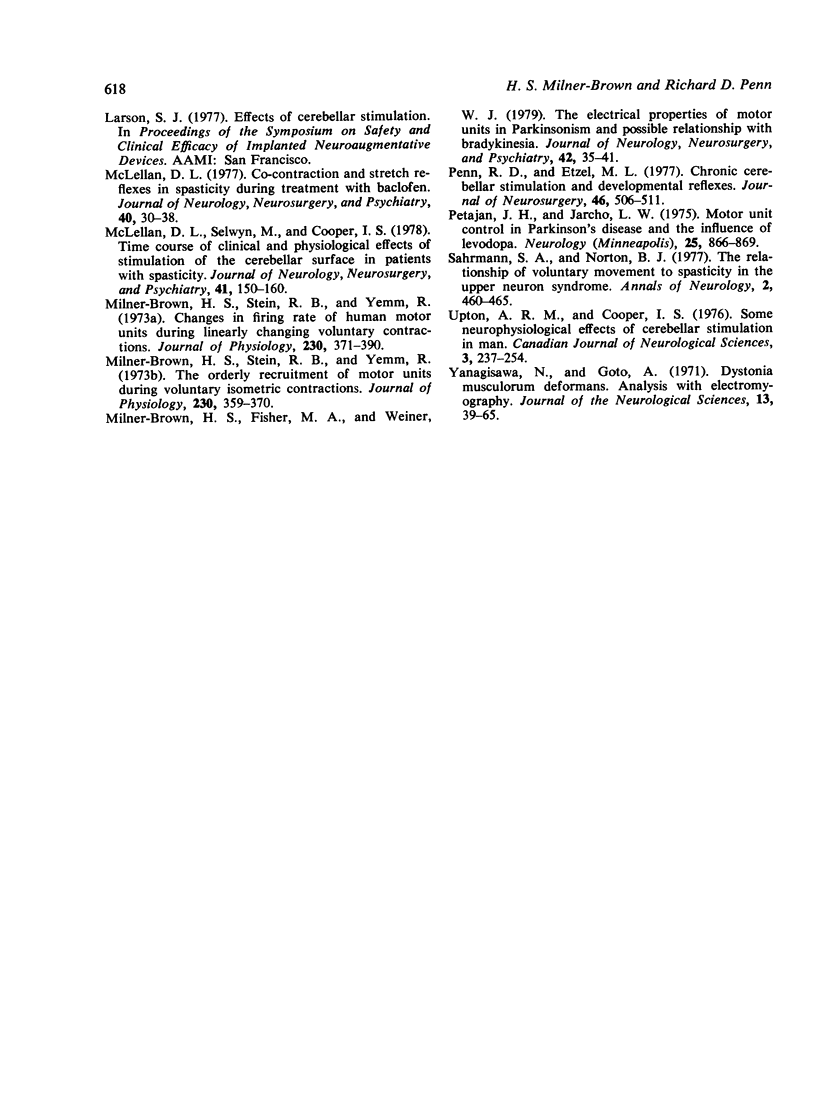
Images in this article
Selected References
These references are in PubMed. This may not be the complete list of references from this article.
- Brooks V. B. Roles of cerebellum and basal ganglia in initiation and control of movements. Can J Neurol Sci. 1975 Aug;2(3):265–277. doi: 10.1017/s0317167100020369. [DOI] [PubMed] [Google Scholar]
- Burke D., Gillies J. D., Lance J. W. Hamstrings stretch reflex in human spasticity. J Neurol Neurosurg Psychiatry. 1971 Jun;34(3):231–235. doi: 10.1136/jnnp.34.3.231. [DOI] [PMC free article] [PubMed] [Google Scholar]
- Cooper I. S., Crighel E., Amin I. Clinical and physiological effects of stimulation of the paleocerebellum in humans. J Am Geriatr Soc. 1973 Jan;21(1):40–43. doi: 10.1111/j.1532-5415.1973.tb00849.x. [DOI] [PubMed] [Google Scholar]
- Cooper I. S. Effect of stimulation of posterior cerebellum on neurological disease. Lancet. 1973 Jun 9;1(7815):1321–1321. doi: 10.1016/s0140-6736(73)91338-x. [DOI] [PubMed] [Google Scholar]
- Cooper I. S., Riklan M., Amin I., Waltz J. M., Cullinan T. Chronic cerebellar stimulation in cerebral palsy. Neurology. 1976 Aug;26(8):744–753. doi: 10.1212/wnl.26.8.744. [DOI] [PubMed] [Google Scholar]
- Desmedt J. E., Godaux E. Ballistic contractions in man: characteristic recruitment pattern of single motor units of the tibialis anterior muscle. J Physiol. 1977 Jan;264(3):673–693. doi: 10.1113/jphysiol.1977.sp011689. [DOI] [PMC free article] [PubMed] [Google Scholar]
- Fisher M. A. Electrophysiological appraisal of relative segmental motoneurone pool excitability in flexor and extensor. J Neurol Neurosurg Psychiatry. 1978 Jul;41(7):624–629. doi: 10.1136/jnnp.41.7.624. [DOI] [PMC free article] [PubMed] [Google Scholar]
- Fisher M. A., Penn R. D. Evidence for changes in segmental motoneurone pools by chronic cerebellar stimulation and its clinical significance. J Neurol Neurosurg Psychiatry. 1978 Jul;41(7):630–635. doi: 10.1136/jnnp.41.7.630. [DOI] [PMC free article] [PubMed] [Google Scholar]
- Gottlieb G. L., Agarwal G. C., Penn R. Sinusoidal oscillation of the ankle as a means of evaluating the spastic patient. J Neurol Neurosurg Psychiatry. 1978 Jan;41(1):32–39. doi: 10.1136/jnnp.41.1.32. [DOI] [PMC free article] [PubMed] [Google Scholar]
- Hagbarth K. E., Wallin G., Löfstedt L. Muscle spindle responses to stretch in normal and spastic subjects. Scand J Rehabil Med. 1973;5(4):156–159. [PubMed] [Google Scholar]
- LANDAU W. M., WEAVER R. A., HORNBEIN T. F. Fusimotor nerve function in man. Differential nerve block studies in normal subjects and in spasticity and rigidity. Arch Neurol. 1960 Jul;3:10–23. doi: 10.1001/archneur.1960.00450010010002. [DOI] [PubMed] [Google Scholar]
- Landau W. M. Editorial: Spasticity: the fable of a neurological demon and the emperor's new therapy. Arch Neurol. 1974 Oct;31(4):217–219. doi: 10.1001/archneur.1974.00490400031001. [DOI] [PubMed] [Google Scholar]
- McLellan D. L. C0-contraction and stretch reflexes in spasticity during treatment with baclofen. J Neurol Neurosurg Psychiatry. 1977 Jan;40(1):30–38. doi: 10.1136/jnnp.40.1.30. [DOI] [PMC free article] [PubMed] [Google Scholar]
- McLellan D. L., Selwyn M., Cooper I. S. Time course of clinical and physiological effects of stimulation of the cerebellar surface in patients with spasticity. J Neurol Neurosurg Psychiatry. 1978 Feb;41(2):150–160. doi: 10.1136/jnnp.41.2.150. [DOI] [PMC free article] [PubMed] [Google Scholar]
- Milner-Brown H. S., Fisher M. A., Weiner W. J. Electrical properties of motor units in Parkinsonism and a possible relationship with bradykinesia. J Neurol Neurosurg Psychiatry. 1979 Jan;42(1):35–41. doi: 10.1136/jnnp.42.1.35. [DOI] [PMC free article] [PubMed] [Google Scholar]
- Milner-Brown H. S., Stein R. B., Yemm R. Changes in firing rate of human motor units during linearly changing voluntary contractions. J Physiol. 1973 Apr;230(2):371–390. doi: 10.1113/jphysiol.1973.sp010193. [DOI] [PMC free article] [PubMed] [Google Scholar]
- Milner-Brown H. S., Stein R. B., Yemm R. The orderly recruitment of human motor units during voluntary isometric contractions. J Physiol. 1973 Apr;230(2):359–370. doi: 10.1113/jphysiol.1973.sp010192. [DOI] [PMC free article] [PubMed] [Google Scholar]
- Penn R. D., Etzel M. L. Chronic cerebellar stimulation and developmental reflexes. J Neurosurg. 1977 Apr;46(4):506–511. doi: 10.3171/jns.1977.46.4.0506. [DOI] [PubMed] [Google Scholar]
- Petajan J. H., Jarcho L. W. Motor unit control in Parkinson's disease and the influence of levodopa. Neurology. 1975 Sep;25(9):866–869. doi: 10.1212/wnl.25.9.866. [DOI] [PubMed] [Google Scholar]
- Sahrmann S. A., Norton B. J. The relationship of voluntary movement to spasticity in the upper motor neuron syndrome. Ann Neurol. 1977 Dec;2(6):460–465. doi: 10.1002/ana.410020604. [DOI] [PubMed] [Google Scholar]
- Upton A. R., Cooper I. S. Some neurophysiological effects of cerebellar stimulation in man. Can J Neurol Sci. 1976 Nov;3(4):237–254. doi: 10.1017/s031716710002535x. [DOI] [PubMed] [Google Scholar]
- Yanagisawa N., Goto A. Dystonia musculorum deformans. Analysis with electromyography. J Neurol Sci. 1971 May;13(1):39–65. doi: 10.1016/0022-510x(71)90206-1. [DOI] [PubMed] [Google Scholar]










